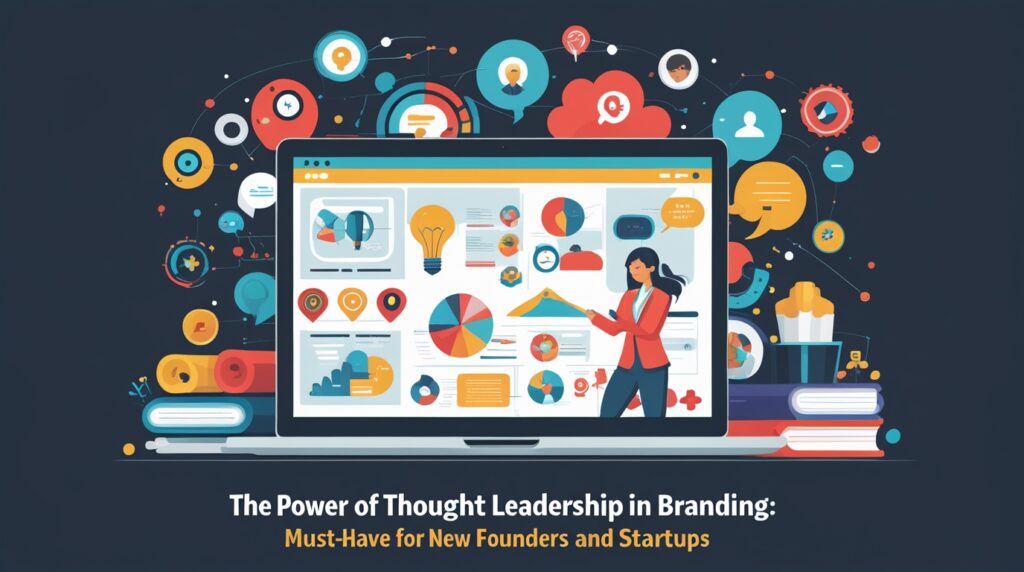In today’s fast-moving digital landscape, building a strong brand is no longer just about having a great logo, catchy tagline, or well-designed website. For new founders and startups, the secret to standing out in a saturated market is clear: Thought Leadership.
As more consumers and investors look for authenticity, vision, and purpose, startups that embrace thought leadership early on are better positioned to build credibility, attract their ideal audience, and secure long-term loyalty. In this article, we’ll explore why thought leadership is essential to startup branding, how to begin building it, and what successful founders are doing differently.

What is Thought Leadership?
Thought leadership is the strategic process of positioning yourself—or your brand—as a trusted authority in your field by sharing valuable insights, perspectives, and original ideas. It’s not about being the loudest voice in the room; it’s about being the most insightful, authentic, and consistent.
According to Denise Brosseau, author of Ready to Be a Thought Leader?,
“Thought leadership is about sharing your unique perspective in a way that influences others to think differently, act decisively, and make meaningful change.”
For new founders and startups, thought leadership becomes a cornerstone of brand building because it builds trust before a transaction ever takes place.
Why Thought Leadership Matters for Startup Branding
1. Trust Is the Currency of the Modern Brand
In the early stages of a business, your reputation is your brand. Without an established customer base or long history of success, people are buying into you—your vision, your values, your insight. Thought leadership allows you to showcase your thinking, not just your product.
Edelman’s 2021 Trust Barometer reported that 68% of people expect CEOs to speak publicly on societal issues. More than ever, founders are not just expected to run companies—they’re expected to lead conversations.
2. It Differentiates You in a Crowded Market
Most startups operate in highly competitive spaces. Products and services can be copied—but your voice, thought process, and lived experience are unique. When you articulate your journey, industry insights, or countercultural beliefs through content, speaking, or interviews, you’re creating a brand identity that no one else can replicate.
As Simon Sinek famously said:
“People don’t buy what you do; they buy why you do it.”
Thought leadership gives you a platform to communicate your why powerfully.
3. It Attracts Investors, Media, and Talent
When investors evaluate startups, they’re betting as much on the founder as they are on the product. A founder who demonstrates clarity of vision and intellectual authority is seen as a lower-risk, high-impact investment.
In fact, a survey by LinkedIn and Edelman found that 89% of decision-makers believe thought leadership enhances a brand’s reputation. It also influences hiring: top talent wants to work for companies with visible, mission-driven founders who are shaping their industries.
How to Build Thought Leadership as a Founder
1. Start with Your Core Message
What unique insight, perspective, or story do you bring to the table? Your thought leadership should be rooted in your authentic experience, values, and vision—not in what’s trending.
Ask yourself:
- What do I know that others in my industry overlook?
- What problems am I obsessed with solving?
- What future am I building toward?
This message becomes the spine of your brand voice across platforms.
2. Create Value-Rich Content Consistently
Content is your thought leadership delivery system. Whether it’s blogs, videos, podcasts, or social media posts, what matters is that you’re educating, inspiring, or challenging your audience with original thinking.
Founders like Rand Fishkin (Moz), Melanie Perkins (Canva), and Whitney Wolfe Herd (Bumble) all built brands by showing up consistently with educational and visionary content in their niches.
Tip: Use LinkedIn, Medium, and YouTube to share your insights regularly. Repurpose content into reels, quotes, or carousel posts for greater reach.
3. Speak, Teach, and Join the Conversation
Visibility isn’t vanity—it’s strategy. Speaking at conferences, hosting webinars, or even guesting on podcasts gives your brand a human voice and builds authority by association.
Remember: when you teach others, you position yourself as someone who leads, not follows. And audiences naturally gravitate toward leaders who are generous with their knowledge.
4. Leverage Micro-Moments
Not every post needs to be a whitepaper. Share what you’re learning, thinking about, or working on—even if it’s in progress. This vulnerability makes your thought leadership relatable.
Author and brand strategist Bernadette Jiwa says:
“The story you tell isn’t just about your product—it’s about how you show up in the world.”
Real-World Examples of Thought Leadership-Driven Startups
- Glossier grew from a blog (Into the Gloss) to a billion-dollar brand because its founder, Emily Weiss, positioned herself as a relatable, transparent voice in beauty culture.
- Y Combinator’s Paul Graham regularly publishes essays on startups and innovation. His clear, no-nonsense thought leadership has become a magnet for founders and investors alike.
- Stripe’s Patrick Collison built a personal reputation as a curious, intellectually engaged founder—frequently sharing what he reads, learns, and thinks on Twitter. This thoughtful transparency translates into brand trust.
The Thought Leadership Architect™ Edge
For founders who feel overwhelmed by the idea of “putting themselves out there,” working with a guide like Thought Leadership Architect™ can help clarify your voice, develop a sustainable content strategy, and build your brand authority with intention.
We help founders:
- Identify signature ideas
- Design a branded thought leadership platform
- Create evergreen and viral content formats
- Build credibility through strategic visibility
In a world that is increasingly noisy, your voice is your brand. As a new founder, embracing thought leadership early doesn’t just build trust—it creates a magnetic brand that attracts the right people, opportunities, and momentum.
If you want to future-proof your startup and lead with vision, now is the time to build your thought leadership platform.
Bibliography
- Brosseau, Denise. Ready to Be a Thought Leader? Jossey-Bass, 2014.
- Sinek, Simon. Start with Why: How Great Leaders Inspire Everyone to Take Action. Portfolio, 2009.
- Edelman. “2021 Edelman Trust Barometer.” https://www.edelman.com/trust/2021-trust-barometer
- LinkedIn & Edelman. “2020 B2B Thought Leadership Impact Study.” https://business.linkedin.com/marketing-solutions/blog/b2b-content-marketing/2020/edelman-linkedin-thought-leadership-study
- Jiwa, Bernadette. Story Driven: You Don’t Need to Compete When You Know Who You Are. Perigee, 2018.


Leave a Reply